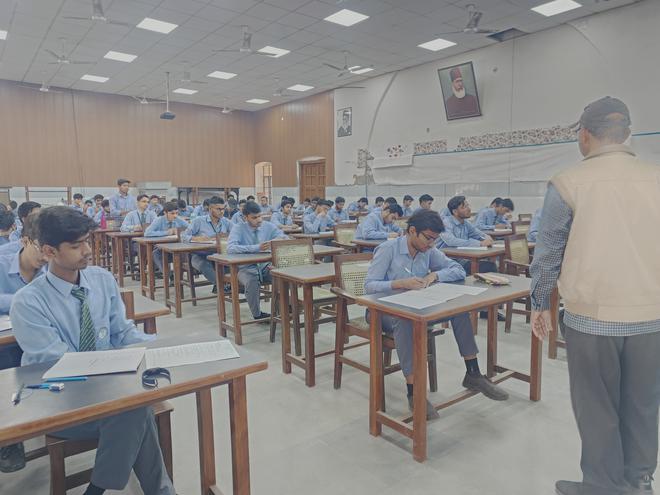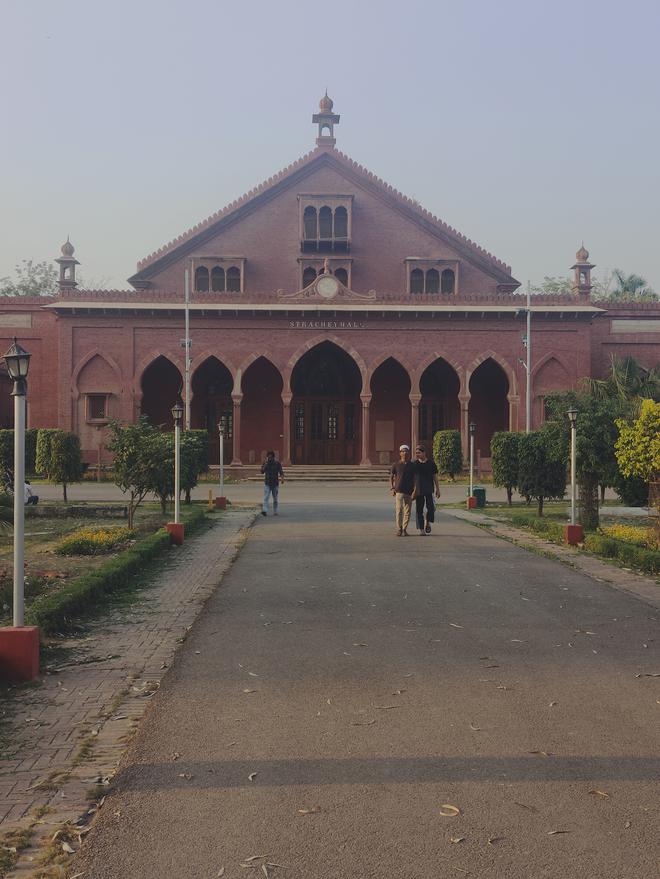While students in the metropolitan cities seek to learn French, Spanish, and Japanese, young boys and girls in Aligarh aspire to tell their seen apart from sheen and qaaf from kaaf. In Aligarh, the city of locks, Urdu is an aspirational language that opens doors to affordable, quality education at Aligarh Muslim University (AMU), whose minority status was challenged in the Supreme Court earlier this year. The hearings concluded on February 1, following which the court reserved its verdict.
Established in 1920, the university has around 40,000 students, of which 30% are non-Muslims. According to sources, the number goes up to 40% in professional courses, particularly medicine and law. Urdu is a compulsory subject for all students till senior secondary. They have to pick between the combination of Advanced Hindi-Elementary Urdu and Advanced Urdu-Elementary Hindi.
At AMU’s Raja Mahendra Pratap Singh Senior Secondary School, Deepanshu Singh (name changed on request), a sixth-standard student, writes a sentence in Urdu to show his proficiency in the language. Deepanshu comes from a modest semi-urban household where nobody knows how to write Urdu in the Nastaliq script. He says he could not secure admission to the English-medium section, so he opted for the Urdu-medium section because his father wanted him to become an internal student of AMU.
The internal quota guarantees 50% seats to students from AMU-affiliated institutions, irrespective of religion, in all university programmes, including much sought-after professional courses like medicine, engineering, law, journalism, and management. Singh is not alone. There are many like him in the 10 schools run by the university.
Even as the BJP-ruled Centre has pleaded for the revocation of AMU’s minority status in the apex court, Uttar Pradesh Chief Minister Yogi Adityanath has often talked about the absence of SC/ST quota in the Central university. The party’s regional leaders have alleged discrimination against non-Muslim students and imposition of Urdu at AMU.
However, it is business as usual for Tripti Nagaich. A double MA in Urdu and Hindi, she runs a coaching centre in the heart of the city where she teaches Urdu to about 150 aspirants seeking admission to AMU. “The love for the language made me study it formally, but now it drives my career,” says the teacher. “Students don’t come to me for the love of Urdu poetry. They want admission in the university to get the tag of an internal student.” Nagaich teaches Hindi to the madrasa students who undertake a bridge course for formal education at AMU.

“There was a time when non-Muslims used to study only in the English-medium sections, but now the demand is such that they join the Urdu-medium sections as well. There are eight to 15 non-Muslim students in each section of the Urdu medium,” says Mohd. Fayyazuddin, vice principal of Raja Mahendra Pratap School, which was recently named after the freedom fighter who donated land for the institute. “There are no rigid compartments. The students in Urdu medium are allowed to write exams of other subjects in English. The certificate doesn’t mention the medium of instruction.”
The legal challenge to AMU’s minority status has created ripples among not only Muslim students but also among the upper caste non-Muslim families who fear that if the minority status is revoked, the SC/ST quota would be implemented in the university, which would scuttle the chances of getting their children admitted to the best educational institute in the region as the general category seats will shrink.
‘Urdu imposition’
One of them, a dentist named Dr. Nishit Sharma, is emerging as the youth face of the BJP in the region. A third-generation AMU alumnus, Dr. Sharma supports the idea of introducing the SC/ST quota in AMU admissions and says he sees “the imposition of Urdu” as a form of discrimination against non-Muslim students. “You have to pass the Urdu test to gain entry. In the entrance test, there are 15 questions on Indo-Islamic culture. These are meant to scuttle the prospects of non-Muslim students.”
“Hamare apne bachche hain [They are our children],” says the officiating Vice-Chancellor Prof. Mohammad Gulrez, referring to non-Muslims on the campus. Admitting that the university scores poorly on perception rankings, he says, “Even the thought of someone questioning our secular credentials makes me feel nauseated.”
Dr. Rahat Abrar, former public relations officer of AMU, who has written extensively on the university’s history, says when the university was founded in 1920, no one could envisage that it would become the biggest and remain the only centre of professional education in the zone. “The University Act of 1920 amended in 1981 states that the university is open to all persons, but the purpose of the university is to promote oriental and Islamic studies and to promote the educational and cultural advancement of the Muslims.”
The backstory
Prof. Aftab Alam, chairman of the Department of Strategic Affairs and Security Studies, says changing the minority status of AMU has never featured in the BJP’s manifestos.
“The party, in its earlier avatar of the Jan Sangh, asked for the restoration of the minority status when the Janata government in 1977 brought a Bill for an amendment in the 1920 Act. When the mid-term elections were called in 1979, the party made the restoration of the minority status of AMU, which became infructuous after the Aziz Basha case of 1967, part of its manifesto.”

When the Congress government restored it in 1981 through an amendment to the AMU Act of 1920, the university did not reserve seats for Muslims. “The need was not felt as the institution was happy with the composition of students,” said Prof. Alam, former secretary of the AMU Teachers’ Association who was part of the backroom team that helped the lawyers frame the AMU’s case in the SC.
The university, he points out, introduced the reservation for Muslims in 2005 only for the post-graduation seats in the medical college because the institute has a very limited number of seats. The move was, however, set aside by the Allahabad High Court, which held the 1981 amendment as unconstitutional. The Centre appealed against the verdict in the SC. However, in 2016, the BJP government withdrew the affidavit given by the UPA government and argued against the minority character.
Changed realities
The answer to whether the 2005 move was a one-off case or whether the reservation will be introduced across the board if AMU’s minority status is restored is rooted in the changed realities.
One, Muslim students might not say it openly, but they feel the increasing number of non-Muslim students in professional courses is hampering their chances. “It is no longer a sprinkling of non-Muslims as envisaged by the founders; it has become a gush of admission seekers,” says a former student union leader, refusing to be named.
Two, at a time when the otherisation of Muslims in society is increasing, families are looking up to AMU to safeguard the interests of their wards. Three, the middle-class Hindu families in the region have no quality alternative to turn to. Prime Minister Narendra Modi laid the foundation of a State university named after Raja Mahendra Pratap in 2021 but it will take time to secure structure and stature.
Prof. Alam says the student reaction is “more psychological given the prevailing situation of Muslims in the country”. “I don’t think the university’s admission or appointment policy is going to change if the verdict goes in AMU’s favour. An educational institution needs social and intellectual vibrancy to work effectively. It is just that the community wants an assurance of its constitutional rights,” he says.
Former MLA and senior Congress leader Vivek Bansal, who is also an alumnus of AMU, says both the Hindus and the Muslims have benefited from the university even as there has been a perception among a section of the majority community of a bias against them.







